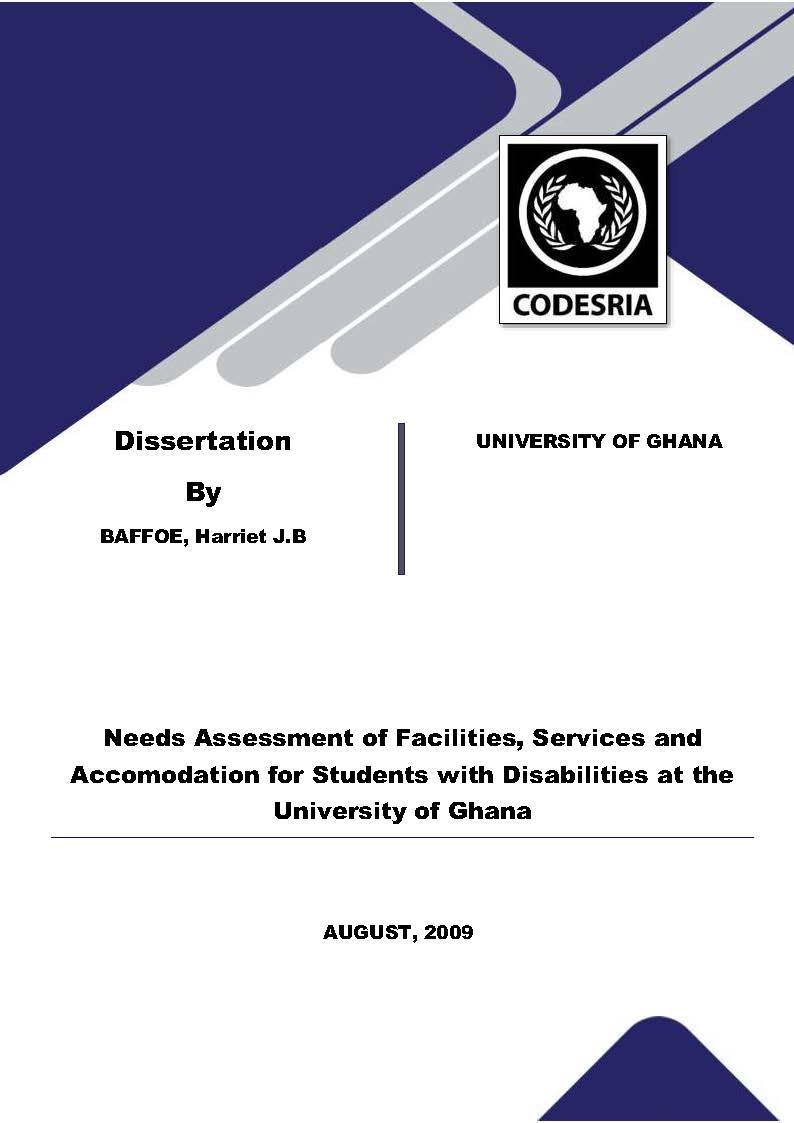Needs Assessment of Facilities, Services and Accomodation for Students with Disabilities at the University of Ghana
Keywords:
Assessment, Facilities, Services and Accomodation, Students, Disabilities, University of GhanaSynopsis
Disability is reported to be one of the wide spread phenomenon especially, in Africa and continues
to rise. Research shows that there are about 600 million persons with disabilities worldwide and
about 5-10 percent live in Ghana. Majority ofthem are faced with inaccessibility to facilities and
services, unequal opportunities especially, to education, employment and to participating fully in
society. The main objective of this research centres on investigating the needs of University of
Ghana students with disabilities. This study adopted the Maslow's hierarchy ofneeds and the Social
model of disability as its theoretical framework. The study sampled 42 respondents and sourced
information from students with disabilities and key informants like resource persons, counsellors,
ICT instructors, librarians and tutorial officiais from the halls of residence at the University of
Ghana. Findings of the study indicated that, though accommodation is provided for all registered
students with disabilities on campus, access to most facilities in the halls of residence remain a
problem. Also, access to most lecture halls and other building structures as well as the campus
shuttle posed lots of difficulties to a good number of the students with disabilities. Many of them
therefore depend on friends for assistance. It was again evident that the provision of disability
services such as brailing, sign language interpretation, note-taking and information dissemination
were inadequate for them. Finally, recommendations focused on meeting the short-term, medium-term
and
long-term needs ofstudents with disabilities at the University of Ghana.
Downloads
References
Access Centre, Ryerson University (2009). Retrieved June 2, 2009 from www.ryers~n.ca
Action on Disability and Development (1996). Retrieved May 21, 2008 from
http://www.daa.org.uk/e trihune%5Ce 1999 01.htm
Amundson, R. (1992). Disability, Handicap, and the Environment. Journal of Social
Philosophy, 23 (1).
Baffoe, H. J. B. (2008). Disability in Ghana. Graduate Exchange Student Programme,
University of Manitoba, Presented at the International Committee of the Canadian Centre on
Disability Studies.
Barnes, C. & Mercer, G. (1996). Exploring the Divide: Accountingfor fllness and
Disability. Leeds, the Disability Press.
Barnes, C. & Mercer, G. (2004). Implementing the Social Model of Disability: Theory
and Research. Leeds, the Disability Press.
Centre for Development of People (1999). CDP, Accra.
Committee on Facilities for Disabled Students Report (1993). University of Ghana, Legon.
Constitution (2007). Campus Association of Students with Disabilities. University of
Ghana, Legon,
DePoy, E. & Gilson, F. S. (2004). Rethinking Disability-Principles for Professional and
Social Change. Brooks, Belmont.
Enable America (2008). Retrieved April 19, 2008, from
http://www.enableamerica.org/reference background. asp
Feldman, R. S. (2000). Essentials of Understanding Psychology. 4th ed. New York:
McGraw-Hill.
Gender Analysis of Selected Disability Movements in Ghana (2008). Ghana Federation of
the Disabled, Accra.
Handbook for Undergraduate Studies (2002/2003). University of Ghana, Legon
Johnson, J. (2000). Students with Disabilities in Post Secondary Education: Issues and
Trends for a New Decade. Perth, Western Australia: Edith Cowan University.
Maslow, A. H. (1987). Motivation and Personality. 3rd ed. New York: Harper & Row.
National Disability Policy Document (2000). Accra, GPC/ Assembly Press.
Neurological Disability (2008). Retrieved May 24, 2008, from
http://www.neads.ca/en/about/projects/inclusion/guide/pwd Ol .php
O'Connor, B. (1991). Policies, Practices and Paradoxes: Disabilities in Higher Education.
Pathways Conference proceedings. Geelong, Vic: Vera White Disability Resource Centre, Deakin
University.
Oliver, M. (1996a). Defining impairment and Disability, Issues at Stake. In Bames C. and Mercer G.
(eds), Exploring the Divide. Leeds: The Disability Press.
Oliver, M. (1996b). Understanding Disability. Basingstoke, Macmillan.
Persons with Disability Act, (2006) Act 715, Republic of Ghana. Accra, GPC/Assembly Press.
Razak, A. (2000). Human Rights and Disability Rightsfor Equal Rights: The Case
of Disabled Persans in Ghana, 1980-2000. MPhil Thesis, Department of Political Science, University
of Ghana.
Reid, I. (1999). Towards a Flexible, Learner-Centred Environment: A discussion Paper.
Perth, Western Australia: Curtin University ofTechnology.
Sandys, J. (2005). Introduction to Disability Studies: Canada-Russia Project.
Toronto: Ryerson University.
Speech and Language Impairments (2008). Retrieved on August 12, 2008, from
http://www.childspeech.net/u i.html
Stickels & Radloff (1996). A New Approach to Improving Education and Training Services for Tertiary
Students with Disabilities. Retrieved on August 9, 2008, from
http://www.
provision/chapter 2.htm
The Women's Manifesto for Ghana (2004). The Coalition on the Women 's Manifestofor Ghana, ABANTU
for Development. Combert Impressions, Accra.
Types of Disabilities (2008). Retrieved on May 24, 2008, from
http://www.apsc.gov.au/abi1ityatwork/3typesofdisabi1ity.htm
Types of Disabilities (2008). Retrieved on May 24, 2008, from
http://www.mylaurier.calaccessible/info/Awareness/TypesofDisabilities/psychd.htm
UPIAS (1976). Fundamental Princip/es of Disability. London: Union of Physically lmpaired Against
Segregation.
United Nations Decade ofDisabled Persans 1983-1992 (1983). Wor/d Programme of
Action Concerning Disabled Persans. New York: United Nations.






